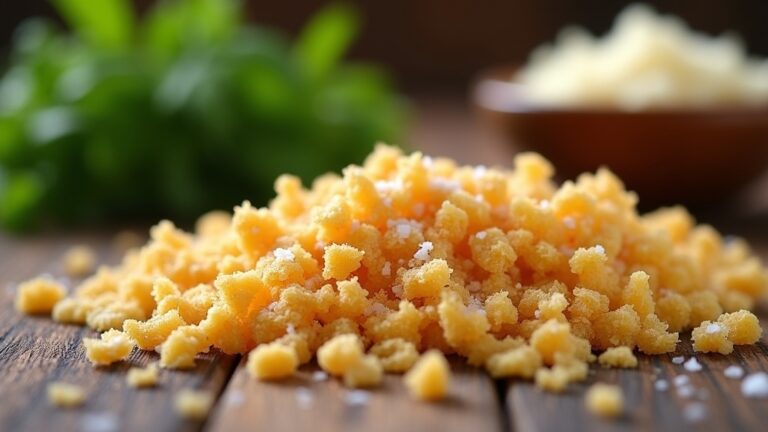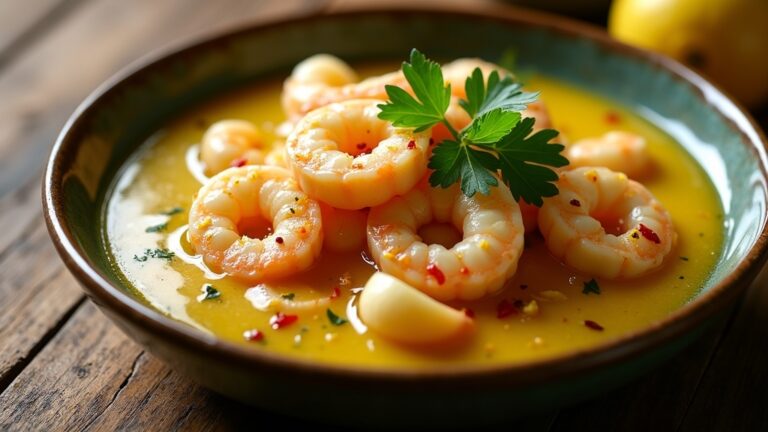White Sauce Recipe
To make a classic white sauce, melt butter in a saucepan without browning it. Gradually whisk in flour, stirring continuously until smooth. Slowly add warm milk, mixing well to prevent lumps. Season with salt and pepper, then whisk until you achieve a velvety texture. This béchamel sauce works great as a creamy base for pasta, gratins, and more. Keep going to discover flavor enhancements and serving suggestions that will elevate your dish.
Contents
History
Although white sauce, or béchamel, may seem like a modern culinary creation, its roots trace back to the 17th century in France. This versatile sauce is a cornerstone of French cuisine, showcasing essential culinary techniques that have stood the test of time. Originally attributed to the chef François Pierre La Varenne, béchamel formed the base for many classic dishes. Its historical origins highlight the evolution of sauce variations, from creamy mac and cheese to rich lasagna. By mastering this foundational sauce, you reveal a world of flavor and creativity in your cooking. Embrace the freedom to experiment, using béchamel as a blank canvas for your culinary artistry, and explore the rich heritage that each spoonful represents.
Recipe
White sauce, also known as béchamel sauce, is a classic French sauce that serves as the foundation for many creamy dishes. It is versatile and can be used in pasta, lasagna, gratins, and even as a base for cheese sauces. The simplicity of this recipe allows home cooks to create a rich and velvety sauce that elevates any dish, making it a staple in kitchens around the world.
To make a perfect white sauce, you’ll need just a few basic ingredients and a little bit of patience. The key is to cook the flour and butter together to form a roux before gradually whisking in milk. This process guarantees the sauce is smooth and free of lumps. With a little practice, you’ll master the technique and have a delicious white sauce ready in no time.
Ingredients:
- 2 tablespoons unsalted butter
- 2 tablespoons all-purpose flour
- 2 cups milk (whole or 2%)
- Salt to taste
- Freshly ground black pepper to taste
- A pinch of nutmeg (optional)
Cooking Instructions:
In a medium saucepan, melt the butter over medium heat. Once melted, add the flour and whisk continuously for about 1-2 minutes to create a roux, allowing it to turn slightly golden but not browned. Gradually pour in the milk while whisking to prevent lumps from forming. Continue to cook the mixture, stirring constantly until it thickens and reaches a creamy consistency, which usually takes about 5-7 minutes. Season with salt, pepper, and nutmeg if desired, and remove from heat.
Extra Tips:
For a richer flavor, consider using whole milk or even adding a bit of cream. If you want a thicker sauce, simply cook it a little longer until it reaches your desired consistency. Remember to whisk constantly to avoid burning the sauce. You can also experiment by adding garlic, herbs, or cheese to create variations of the basic white sauce, enhancing the flavor profile for different dishes.
Cooking Steps
To start making your white sauce, melt butter in a saucepan over medium heat. Gradually add flour, stirring constantly until it forms a roux. Then, slowly pour in the milk while whisking until the mixture is smooth and creamy.
Step 1. Melt Butter in Saucepan
Start by placing a saucepan over medium heat and adding the butter. Choose a saucepan size that suits your recipe; a smaller one works for single servings, while a larger one caters to bigger batches.
- Use unsalted butter for precise control over seasoning.
- Allow the butter to melt slowly, ensuring it doesn’t brown.
- Keep an eye on it, stirring occasionally for even melting.
- If you prefer a richer flavor, consider using clarified butter.
- Once melted, it should be a smooth, golden liquid, ready for the next step.
Step 2. Add Flour Gradually
With the melted butter ready in the saucepan, it’s time to add the flour. Choose your preferred flour type—all-purpose flour is a reliable choice, but you can experiment with whole wheat or gluten-free options. Measure out the flour accurately using a spoon to scoop it into a dry measuring cup, then level it off with a knife. Begin by adding the flour gradually, about a tablespoon at a time. Stir continuously with a whisk to avoid clumps. This technique helps create a smooth paste, known as a roux, which forms the base of your white sauce. Keep stirring until the mixture bubbles gently, and you notice a subtle change in color, signaling it’s ready for the next step.
Step 3. Add Milk Slowly
As the roux bubbles gently in the saucepan, it’s essential to add the milk slowly to achieve the perfect consistency for your white sauce. Start with warm milk to avoid shocking the roux, allowing for a smoother blend.
- Gradually pour in the milk, stirring continuously.
- Keep the heat on low to prevent scorching.
- Watch for lumps as you mix, ensuring a silky texture.
- Adjust the milk temperature for easy incorporation.
- Continue until the sauce thickens to your desired consistency.
This slow addition allows the mixture to integrate beautifully, creating a rich and creamy sauce that’s versatile for countless dishes. Enjoy the freedom of crafting a delicious base that enhances your culinary creations!
Step 4. Season With Salt and Pepper
To elevate your white sauce, seasoning it with salt and pepper is essential. Start by adding a pinch of salt, then taste your sauce. You’re aiming for a flavor balance that enhances the creaminess without overpowering it. Remember, you can always add more, but it’s tough to correct if you over-season. Use freshly cracked black pepper for a subtle kick; it adds depth without being too sharp. As you season, stir gently to incorporate the spices evenly. Keep in mind these seasoning tips: adjust gradually, and let the sauce simmer a few moments after seasoning to meld the flavors. This careful approach guarantees your white sauce complements any dish beautifully, inviting freedom in your culinary creations.
Step 5. Whisk Until Smooth
After seasoning your white sauce with salt and pepper, it’s time to guarantee it reaches the perfect consistency. Use these whisk techniques to achieve a smooth consistency that’ll elevate your dish:
- Start with a sturdy whisk for better control.
- Whisk vigorously in a circular motion to blend ingredients.
- Focus on breaking up any lumps that may form.
- Gradually increase your speed as the sauce thickens.
- Keep whisking until you see a glossy, uniform texture.
As you whisk, feel the transformation—your sauce should become velvety and inviting. This step is essential, so don’t rush it. Enjoy the process, and soon you’ll have a white sauce that’s ready to complement your favorite dishes with ease and flair!
Nutritional Guide
Understanding the nutritional value of white sauce can help you make informed choices in your cooking. This sauce offers several nutritional benefits, including protein from milk and vitamins from added ingredients. However, you can also explore ingredient alternatives to tailor it to your dietary needs.
Here’s a quick nutritional overview:
| Ingredient | Nutritional Benefits | Alternatives |
|---|---|---|
| Whole Milk | Rich in calcium and protein | Almond milk, coconut milk |
| Butter | Source of healthy fats | Olive oil, avocado oil |
| Flour | Provides carbohydrates | Whole wheat flour, gluten-free flour |
| Cheese | Adds flavor and calcium | Nutritional yeast, vegan cheese |
Experimenting with these options can make your white sauce healthier and more suited to your lifestyle.
Final Thoughts
Crafting the perfect white sauce can transform your dishes and elevate your culinary creations. With a few simple cooking tips, you can master this versatile sauce and experiment with various sauce variations. Here are some ideas to inspire you:
- Add cheese for a creamy Mornay sauce.
- Incorporate garlic for a flavorful twist.
- Stir in herbs for a fresh, aromatic touch.
- Use stock instead of milk for a savory base.
- Experiment with spices to personalize the flavor.
Embrace your creativity in the kitchen and don’t hesitate to adjust the recipe to suit your palate. Remember, each batch can be unique, reflecting your style. So, go ahead, whip up that white sauce, and let your dishes shine with your culinary flair!
Frequently Asked Questions
Can I Use Non-Dairy Milk for the White Sauce?
Absolutely, you can use non-dairy milk for your sauce alternatives. Almond, soy, or oat milk works well, creating a creamy texture. Just adjust seasoning and thickness to achieve the flavor you desire. Enjoy your freedom in cooking!
How Can I Thicken the White Sauce Further?
If you’re looking to thicken your sauce, try making a cornstarch slurry or the roux method. Just mix cornstarch with water, or cook equal parts flour and fat, stirring until you achieve your desired consistency.
What Are Common Variations of White Sauce?
When you explore common variations of white sauce, consider cheese sauce for a creamy twist or mushroom sauce for an earthy flavor. Each option enhances dishes, giving you the freedom to create unique culinary experiences.
How Long Can I Store Leftover White Sauce?
Picture that creamy, dreamy sauce lingering in your fridge. You can store leftover sauce for about three to four days, keeping its shelf life vibrant. Just seal it tight to maintain that delightful flavor!
Can White Sauce Be Frozen for Later Use?
Yes, you can freeze white sauce for later use! To maintain its sauce consistency, use proper freezing techniques like cooling it completely, then transferring to airtight containers. Thaw it in the fridge before reheating for best results.
Conclusion
In the grand culinary tapestry, white sauce stands as a symbol of simplicity and versatility, much like the blank canvas of a master painter. As you whisk together butter, flour, and milk, remember that you’re not just creating a sauce; you’re crafting a foundation for countless dishes that echo through kitchens around the world. So, embrace this timeless recipe, and let your creativity flourish, transforming humble ingredients into delightful meals that inspire and satisfy.



